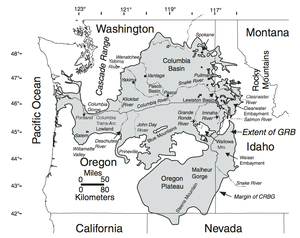Columbia River Basalt Group
- Rocky Mountains (Wikipedia)
The Rocky Mountains, also known as the Rockies, are a major mountain range and the largest mountain system in North America. The Rocky Mountains stretch 3,000 miles (4,800 kilometers) in straight-line distance from the northernmost part of western Canada, to New Mexico in the southwestern United States. Depending on differing definitions between Canada and the U.S., its northern terminus is located either in northern British Columbia’s Terminal Range south of the Liard River and east of the Trench, or in the northeastern foothills of the Brooks Range/British Mountains that face the Beaufort Sea coasts between the Canning River and the Firth River across the Alaska-Yukon border. Its southernmost point is near the Albuquerque area adjacent to the Rio Grande rift and north of the Sandia–Manzano Mountain Range. Being the easternmost portion of the North American Cordillera, the Rockies are distinct from the tectonically younger Cascade Range and Sierra Nevada, which both lie farther to its west.
 Columbia River Basalt Group map shows main regions of basalt exposure in Washington, Oregon, Idaho and Nevada, USA. (usgs.gov)
Columbia River Basalt Group map shows main regions of basalt exposure in Washington, Oregon, Idaho and Nevada, USA. (usgs.gov) Columbia River Basalt Group map shows main regions of basalt exposure in Washington, Oregon, Idaho and Nevada, USA. (usgs.gov)
Columbia River Basalt Group map shows main regions of basalt exposure in Washington, Oregon, Idaho and Nevada, USA. (usgs.gov)
